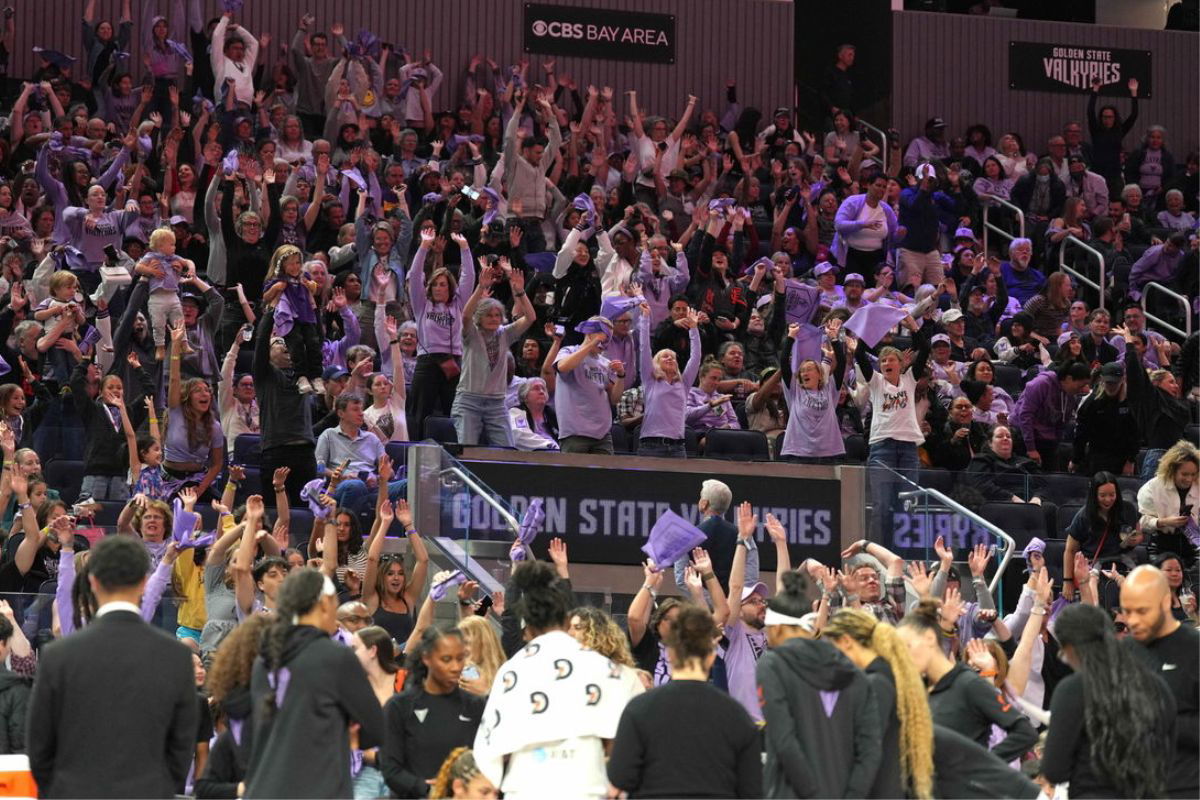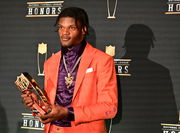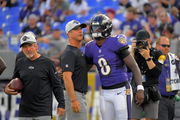
Imago
Jun 22, 2025; San Francisco, California, USA; Golden State Valkyries fans perform the wave during the fourth quarter against the Connecticut Sun at Chase Center. Mandatory Credit: Darren Yamashita-Imagn Images

Imago
Jun 22, 2025; San Francisco, California, USA; Golden State Valkyries fans perform the wave during the fourth quarter against the Connecticut Sun at Chase Center. Mandatory Credit: Darren Yamashita-Imagn Images
Can we all agree that the WNBA is the best comeback story sports has ever seen? The last time the league expanded was all the way back in 2008. After years of waiting, hoping, and chanting for growth, it finally opened its arms again. This time to welcome the Golden State Valkyries. And while they took an L in their debut, that night still felt like a massive W for women’s basketball. Why? 18,000 fans packed the Chase Center in San Francisco. Not just to watch, but to belong. They showed up in purple and black, they stayed loud, and they already planned their return for the next game.
Watch What’s Trending Now!
Meanwhile, in Indy, the records haven’t stopped falling since last year. It’s like we’ve all been waiting for the world to catch up to what we already knew: that this league is special. But as fans, it’s fair to ask – are we seeing the start of something long-term? Or could this rise be peaking faster than we expected?
ADVERTISEMENT
The Numbers Don’t Lie: WNBA’s Leap
We know that 2024 was the most-watched regular season in 24 years. The sport drew its biggest crowds in over two decades, and shattered records for digital engagement and merch sales. But did you know it actually leapfrogged some of the big leagues along the way?
Catching Up to the Big US Leagues
The WNBA’s average attendance has surged by an impressive 52% over the past decade, towering over the NBA’s modest 5% growth in the same time frame. Leading the charge is the Indiana Fever, averaging around 16,680 fans per game this season (as of May 2025), outpacing the rest of the league and drawing crowds that rival long-established franchises. League-wide, the WNBA is averaging about 10,880 fans per game through 26 games, a solid year-over-year jump that signals rising momentum.
ADVERTISEMENT
When stacked up against other major leagues, the picture gets even more interesting. The NHL’s 2024–25 mid-season average attendance sits at 17,225- a figure that has remained fairly steady and still mirrors numbers seen in elite NBA and MLB markets. Most MLB teams still average between 20,000 and 30,000 per game, while the NHL floats around 17,448, but in key cities, the WNBA’s median attendance is starting to narrow the gap.
Top Stories
‘RIP’: NASCAR World Crumbles in Tears as 39-YO Former JR Motorsports Driver Passes Away

Bills Announce Historic Josh Allen News Before Bengals Game

Ravens’ Lamar Jackson Demands Short-Term Contract Away From NFL on Thursday

Chiefs Veteran Gives Up on Playoff Hopes With Patrick Mahomes & Travis Kelce Facing the Impossible

Lamar Jackson Has Reportedly Been Seeking John Harbaugh’s Firing for Years as Locker Room Secret Leaked

Donald Trump Takes Unexpected Shot at NFL With Name Change Call During FIFA World Cup Draw

ADVERTISEMENT
An Expansion Team Is Worth $500 Million
The Golden State Valkyries is now reportedly the most valuable women’s professional sports franchise in the U.S., with an eye-popping valuation of $500 million. That figure nearly doubles the current average franchise valuation across the league. Just 18 months ago, Joe Lacob and Peter Guber acquired the franchise rights for a reported $50 million. Now, thanks to smart branding, savvy market positioning, and the WNBA’s growing spotlight, that investment is paying off in a big way.
NEW @WNBA Team Valuations: The Golden State @valkyries are the first $500 million women's team in pro sports, and every WNBA team value is up more than 100% over the past 12 months. The WNBA teams are collectively worth $3.5 billion.
The latest from @kbadenhausen ⤵️ https://t.co/XXLftYmfpQ pic.twitter.com/W2kFBGk4xG
— Sportico (@Sportico) June 24, 2025
And it’s not just the Valkyries. Across the board, WNBA franchise valuations are soaring. The league’s 13 teams are now collectively worth $3.5 billion, with the average team valuation jumping to $269 million. For context, that’s nearly triple the $96 million average reported just last year, a staggering 180% increase year-over-year. This spike in value represents the largest single-year growth ever seen across any major professional league, even surpassing the NBA’s 2014 jump following Steve Ballmer’s landmark purchase of the Clippers.
ADVERTISEMENT
Broadcast Boom and Sponsor Gold Rush
Rising attendance isn’t just filling seats; it’s turning heads at major networks and boardrooms alike. High in-arena numbers are translating into record-breaking broadcast ratings, and platforms like ESPN, CBS, and Amazon are jumping in to ride the WNBA wave. For the first time in league history, multiple preseason games aired on national TV. And that’s just the beginning.
ABC is broadcasting 13 regular-season games this year – its most ever – while ION leads the way with 50 matchups across the full 44-game slate. Meanwhile, CBS made headlines by airing the first-ever WNBA primetime games on broadcast television, including the must-watch Fever vs Sky matchups on June 7 and August 9.
ADVERTISEMENT
This momentum isn’t lost on sponsors either. That faith has already paid off in the form of a record-shattering media rights deal, estimated at $2.2 billion over 11 years. Spread across Disney (ESPN), NBCUniversal, and Amazon, the deal averages $200 million annually, quadruple the value of the league’s previous contract. The best part is there’s a clause built for growth. Media partners have agreed to revisit the terms after three years, leaving the door open for a valuation bump if the current trajectory holds.
But is there a chance it can turn the other way around?
ADVERTISEMENT
Unpacking Sustainability Concerns
While culturally the league is thriving, one of the quieter concerns as the fan base grows is the shifting atmosphere. Some longtime supporters have voiced worries about rising heckling, more aggressive in-game behavior, and climbing ticket prices – all of which are starting to create a subtle tension. Beyond that, other factors are:
Star-Dependent Popularity
There’s no denying it that Caitlin Clark has been one of the biggest driving forces behind the WNBA’s recent surge. Paige Bueckers, with her long-standing college following, and Hailey Van Lith, known for her massive social media presence, were also expected to bring their own waves of fans. And while this kind of star loyalty is great for visibility, it raises a critical question: are fans showing up for the game, or just for the stars?
ADVERTISEMENT
We’ve already seen how this plays out. Multiple franchises moved their games to larger arenas when hosting the Indiana Fever, solely because of the expected Clark-fueled turnout. That bet paid off as Indiana’s average attendance hit 16,757 this season, nearly doubling road figures. But there’s a flipside. When Clark missed time in May, ticket sales plunged. Attendance dropped by 47 to 71 percent for those games, and resale markets saw similar dips. The message was simple. Without the headline act, the seats empty fast.
This is what makes the league’s current growth feel a bit precarious. Riding a wave of one player’s popularity can spark short-term gains, but the long-term health of the WNBA hinges on fans investing in the entire product.
ADVERTISEMENT
Persistent Financial Losses Testing Investor Patience
Despite record-breaking numbers, the WNBA is still far from turning a profit. In the 2024 season alone, the league reportedly lost $40 million, slightly better than the originally projected $50 million, but still a substantial shortfall. Since the league’s inception in 1996, NBA team owners have poured hundreds of millions into supporting its growth, yet many are beginning to question the return on investment.
While the league’s momentum is undeniable, frustration is growing behind the scenes. Some NBA owners are now pressing Commissioner Adam Silver for more transparency about when – and how – they’ll begin to see financial returns from the suddenly surging WNBA.
Expansion or Brand Dilution?
Yes, for years, fans and players have pushed for more roster spots, especially with the influx of elite college talent and international players. But are we heading in the right direction? The WNBA has recently celebrated its return to former markets like Cleveland and Detroit while also eyeing new territory in Philadelphia. But as exciting as this expansion era may seem on paper, it’s raising some legitimate concerns.
Currently, only about half of the WNBA’s 12 teams reportedly turn a profit in any given season. And even with the NBA’s backing. That matters because historically, the lack of financial stability has caused several franchises to either fold or relocate. See..growing to 16 teams feels reasonable but this kind of fast expansion could water down the product, stretch the talent pool, and erode the unique culture that makes the WNBA what it is.
Expansion means more teams, but it also means more pressure on broadcasting, sponsorships, front office talent, and fanbases. If the goal is to build something truly sustainable, then protecting what’s already working should be just as important. What if, instead, the league focused first on improving the player experience? That brings us to the next issue.
Growing Cultural Rift Between Players & FO
Outside of fans and media, the two most crucial pillars of the WNBA ecosystem are its players and front offices. But right now, those two sides don’t exactly seem to be on the same page, As negotiations around the next collective bargaining agreement heat up, frustration is bubbling.
Sources close to the negotiations confirmed that the WNBA recently sent its first formal proposal to the players’ union, but it fell flat—failing, they say, to meaningfully respond to player concerns. Satou Sabally, a WNBPA player representative, didn’t hold back, calling the league’s first proposal “a slap in the face.” She added, “I love to see the league growing. … But how cool would it also be to have a little bit of expansion on the rosters? Let’s focus on the teams that have everything set up right now.”
“Absolutely frustrated,” Breanna Stewart said of the league’s approach. “They kind of just ignored everything we said.” But it’s not just about pay or roster sizes, it’s also about access and respect. Sabrina Ionescu pointed out another glaring issue: players feel they can approach NBA Commissioner Adam Silver with ease, but don’t have the same relationship with WNBA Commissioner Cathy Engelbert.
That kind of disconnect speaks volumes about the communication gap. These aren’t small gripes. A culture clash between the league’s front offices and its players threatens more than just locker room morale.
It risks:
- Missed opportunities for collaboration
- Delayed growth initiatives
- Deeper fractures down the line.
For a league banking on long-term momentum, that’s a dangerous place to be.
Can the WNBA Keep Building?
First let’s get one thing loud and clear: The WNBA is no longer a small-market story. But now comes the real test: Can that energy last? Yes, there are doubts but what’s happening right now is very real, whether filed by one player or specific franchises. This is more than just monetary investment. Legends like Dawn Staley, icons like Malala Yousafzai, and champions like Simone Biles are wanting to buy stakes because they believe in what this league represents.
So it’s time for the business world to respond with equal belief and a challenge for the league to work on problems to sustain this momentum. Because in sports, moments create movements but only strong infrastructure turns those movements into lasting legacies.
ADVERTISEMENT
ADVERTISEMENT
ADVERTISEMENT

